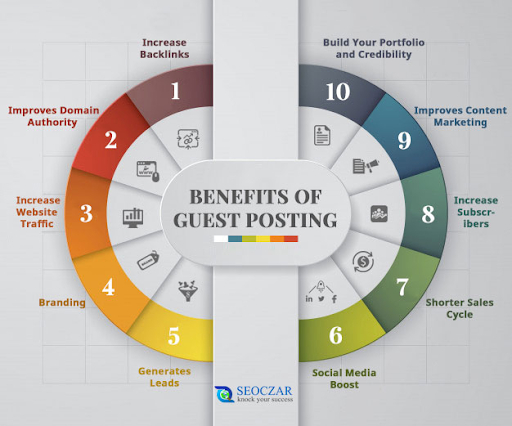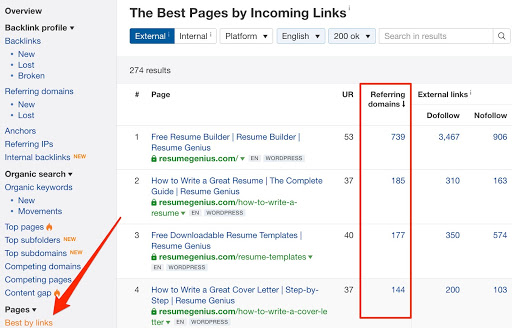7 Techniques That Will Improve Guest Blogging For Your Brand

Question: Is guest blogging one of the best inbound marketing strategies for your brand?
Answer: Yes.
At first, this might make little sense. You might ask yourself, "Why should I spend time writing for someone else? I'd rather spend that time promoting my blog on social media".
Guest blogging on websites and blogs within your niche gives your content some much-needed exposure to a broader relevant audience, attracts traffic to your website, and builds up your backlink profile. In other words, guest blogging is a tried and tested strategy for building the authority of your brand, and one that you would be smart not to ignore.
Benefits of Guest Blogging
Guest blogging positions you as a thought leader in your industry while delivering your message directly to an audience that appreciates your work.
There are five primary benefits that guest blogging can offer to your brand:
- Greater exposure
- Higher credibility
- Social media growth
- More inbound links
- The potential to build a professional network
Let's discuss each benefit in more detail, then look at a case study of a brand leveraging guest blogging to boost credibility.
Greater Exposure
Guest blogging allows you to get your name, face, and content in front of a large audience. Every time you publish a guest blog, you get a byline with your name, picture, and a brief biography on it. Not only will the blog's readers read your content, but they will also get to know who you are, who you represent, and how to reach you.
Higher Credibility
Search engines like Google give a higher search ranking to expert writers. Posting guest blogs on reputable sites gives your brand higher search rankings. In addition, it builds up your credibility as an industry leader and gives your voice greater authority with the target audience.
Social Media Growth
A natural by-product of exposure and credibility is a boost in social media followers. If a reader likes your work, they will be more inclined to follow you on platforms like LinkedIn and Twitter, which in turn will give them direct access to more of your content.
Beyond the organic growth of your social network, your articles are more likely to be shared on various social platforms, increasing your visibility.
Inbound Links
Most websites will allow you to include your website's URL in the byline or biography section. Aside from this, they may also allow 2-3 backlinks to relevant pages on your blog within the article. Adding backlinks to your guest post will improve your domain authority and search engine performance while encouraging readers to visit your website.
Networking
Posting guest blogs is a good way to build your professional network. As your guest articles gain more readers, you get opportunities to collaborate with other bloggers and engage your new audience by replying to their comments. Every conversation is an opportunity to build your brand and establish your reputation as an authority in your niche.
Case Study: Growth Tools
Bryan Harris is the founder of Growth Tools, a digital marketing agency. His first guest post on marketing blog Okdork, "How to get your first 100 email subscribers", gave him over 8,000 email subscribers and paved the way to a $15,000-per-month blogging career.

Before Harris published his guest blog, his blog (videofruit.com) received an average of 285 visitors per day. The day after his guest post was published on OKDork, his blog received 1076 visitors, close to four times its normal traffic.
While your site won't get that sort of immediate boost with every new guest post you publish, Videofruit's experience should serve as an example of what guest posting can do for you. Let's look at some of the techniques you can use to get you started with guest blogging, then sustainably scale your output.
7 Techniques for Scaling Your Guest Blogging Campaigns
Now that you have decided to make guest blogging a key facet of your digital marketing strategy, let's look at the steps you need to take to make that happen. These steps will help you create a timeline for implementing and scaling your guest blogging campaign.
Beginning a guest blogging strategy doesn't mean you'll scale down your other marketing activities. In fact, you can use your other marketing channels to promote your guest posts. For example, you can share them on social media. You may also build an email list (use an email verifier to help you) and distribute your brand newsletter to your new fans.
1. Set Your Goals
Your first task is to define the goals of your guest posting campaign. Defining clear, tangible goals will allow you to identify your audience and the sites you need to target. The three basic goals of guest blogging are:
- To establish your brand as an industry thought leader.
- To gain visibility and drive traffic to your website.
- To build backlinks to your website.
Writing top-notch content on the best sites will help you achieve all three objectives. You'll need to find blogs with high traffic and an engaged audience and, if gaining backlinks is important to you, you'll need to target sites with a strong root domain authority (DA). Many high-traffic sites also have high DA scores, and vice-versa.
Set your goals to know which sites you should be targeting. Oh, and make sure your goals are SMART: Specific, Measurable, Achievable, Relevant, and Time-bound.
2. Start Small
If you are just starting a guest blogging campaign, it's best to start small and go for more realistic target sites. Contacting Forbes or the Harvard Business Review at this point (probably) won't get you anywhere and will just waste your time.
Your next task is in finding relevant blogs to target. To find suitable sites for your guest posts, you can reverse engineer your way to success. Here's how.
Start by identifying someone who writes guest blogs in your niche, then find out where they post their guest content. For instance, Noah Kagan posts a lot of blogs in the digital marketing space. Go to his author bio in one of his posts and copy the URL of his picture.

Copy the link, paste it in the Google Images search bar, and voila! You will see a list of the sites he has posted on.

You can similarly reverse engineer Twitter feeds and your competitors' backlinks. To identify smaller blogs that have medium domain authority, run the ones you find through the Ahrefs website authority checker. These types of sites tend to be more open to guest posts and will give your own site's DA a boost, as well.
When I'm looking for sites to write for, I base my outreach strategy on the following factors:
- Domain Rating of 50+
- 3,000+ unique visitors per month
- Trust Flow 20+
- Relevant niche
These exact metrics may not work for you, but I think they're a good starting point if you want to reap the benefits of guest posting.
3. Build a Relationship, Choose a Topic, and Make Your Pitch
One of the best ways to build a relationship with blog owners is to share their content on social media platforms like Twitter, Facebook, and LinkedIn. Posting insightful and helpful comments on blogs will also build familiarity and establish you as a possible contributor. If you have issues finding the email contact of the blog owner, you can always use an email API to find the address.
Now it's time to start communicating with site owners, but you're not going to pitch your ideas just yet. Remember that an outreach email that will eventually lead to a guest post request is a type of networking email, so treat it accordingly.
Keep your first email short and simple. It might look something like this:
"Hi [Name],
Your recent blog on [Topic] was very insightful and helped me a lot.
I used [Tip or technique mentioned in the blog] and was delighted by [Result]. Hence, I just wanted to send an email to say thank you!
Thanks again,
[Your first name]
You are now on their radar, and they are warmed up to hear your pitch. Good luck!
A couple of weeks later, you can reach out again - this time, to ask about contributing a guest post. If they respond favorably, pitch some suitable topic ideas.
To identify the topics you could write about, check out what they've already covered and what received the highest views and social shares. Look for topical gaps and keyword gaps that you could fill, and pitch relevant topics accordingly.
4. Pitch to Multiple Sites
Don't put all your eggs in one basket. Instead of pitching to just one site at a time, replicate the process for each site you'd like to write for. Just remember to personalize all your outreach emails.
Pro tip: You can't pitch the same ideas to different sites (or at least not in exactly the same format). You will need to research each site and come up with unique topics for each one.
5. Use the Skyscraper Technique
In 2015 Brian Dean, the founder of Backlinko, shared a link-building technique to increase organic traffic to a website. He called it the Skyscraper Technique. In a nutshell, this is how the skyscraper technique works:
- Find content on reputable sites that you think could be written better.
- Write on the same topic, but add to it or use a new perspective.
- Contact the site owners and ask them to link to your superior content.
This strategy builds on people's desire to get access to the best content available. For example, if you come across an article titled "5 Ways to Get More Website Traffic" then find another one titled "10 Ways to Increase Your Site Visitors", you'll tend to read the one that offers to teach you more techniques.
As you keep gaining experience as a guest blogger, you can adopt the skyscraper technique to easily build inbound links from websites with high domain authority.
Case Study: RawResume.com
Dale Cudmore, a full stack developer, and digital marketer used the Skyscraper Technique on his now-defunct site RawResume.com. He started by identifying a resume writing guide that had a lot of backlinks, and one where the content could be improved. He imported the URL into Site Explorer to get details of the backlinks.
The post he targeted for re-writing and using the skyscraper technique was How To Write a Great Resume:
Dale now had 186 skyscraping opportunities. Note: The number of referring domains is more relevant than the backlink number because multiple links can refer to the same domain.
Dale re-wrote this article as Free Resume Builder, and the results on the "Best by links" section on Site Explorer is proof that the skyscraper technique works wonders if done correctly:

Once you have identified the post that you would like to use for skyscraping, rewrite it and add it to your blog. Next, send an outreach mail to the targeted blog, where your message should cover the following points:
- Why you are reaching out
- The link to your content (the article you rewrote)
- Why your article is better than the one they are linked to
- End with a CTA asking them to swap the link
With the right approach and implementation, you will soon reap the benefits of this innovative and effective strategy.
6. Break Long Articles into Focused Pieces
Technology is changing the way we consume information, and the average human attention span is shrinking. Hence, it is important to keep your blogs focused on the topic.
Keep in mind that you will have different types of readers. Some readers will read the entire article from start to finish. Others may just read the headlines and introduction and scan the headings and pictures to get a gist of the content.
If a topic requires 3,000 words to do justice to the topic, try and break it up into two blogs of around 1,500 words each. The title of each post should be a long-tail keyword to gain more visibility on Google. You also need to break up the text using appropriate headings and images to keep your readers interested.
7. Link Back to Your Previous Articles
When you publish a guest post, most websites will give you space for a bio where you can add a link back to your website. Many sites also offer you the opportunity to insert a couple of relevant links within the body of the blog. These links will play a major role in increasing your site traffic and improving your domain rating, so choose your links and anchor text wisely!
Let's say your objective is to build your email subscriber list. Start by creating a niche-specific freebie to give away. This could be in the form of an ebook or other exclusive content. You can build a specific landing page where visitors can sign up for your mailing list to get access to the content, then use your guest post to link back to the landing page.
Promote your guest posts on your social media platforms and your own website. Pay attention to the comments that your blog attracts and make sure you respond to each comment if possible. This will help you write better guest content in the future by identifying topics that your readers are most interested in, as well as cementing your reputation as a knowledgeable authority in your industry.
Wrapping up
Guest blogging is one of the most powerful tools you can use to market your brand online. It helps in building your brand credibility, driving organic traffic to your site, and improving your search engine rankings.
Once you've got your first few guest posts published, you might want to scale your strategy. You can hire a content ghostwriter, a project manager, or someone to perform outreach on your behalf to help you if you don't have time to do it all yourself.
A step by step approach to guest posting will help in building your brand reputation and your image as a thought leader. Good luck with your guest blogging - I can't wait to see what you write!
This guest article was written by Owen Baker, a content marketer for Voila Norbert, an online email verification tool. He has spent most of the last decade working online for a range of marketing companies. When he's not busy writing, you can find him in the kitchen mastering new dishes.


